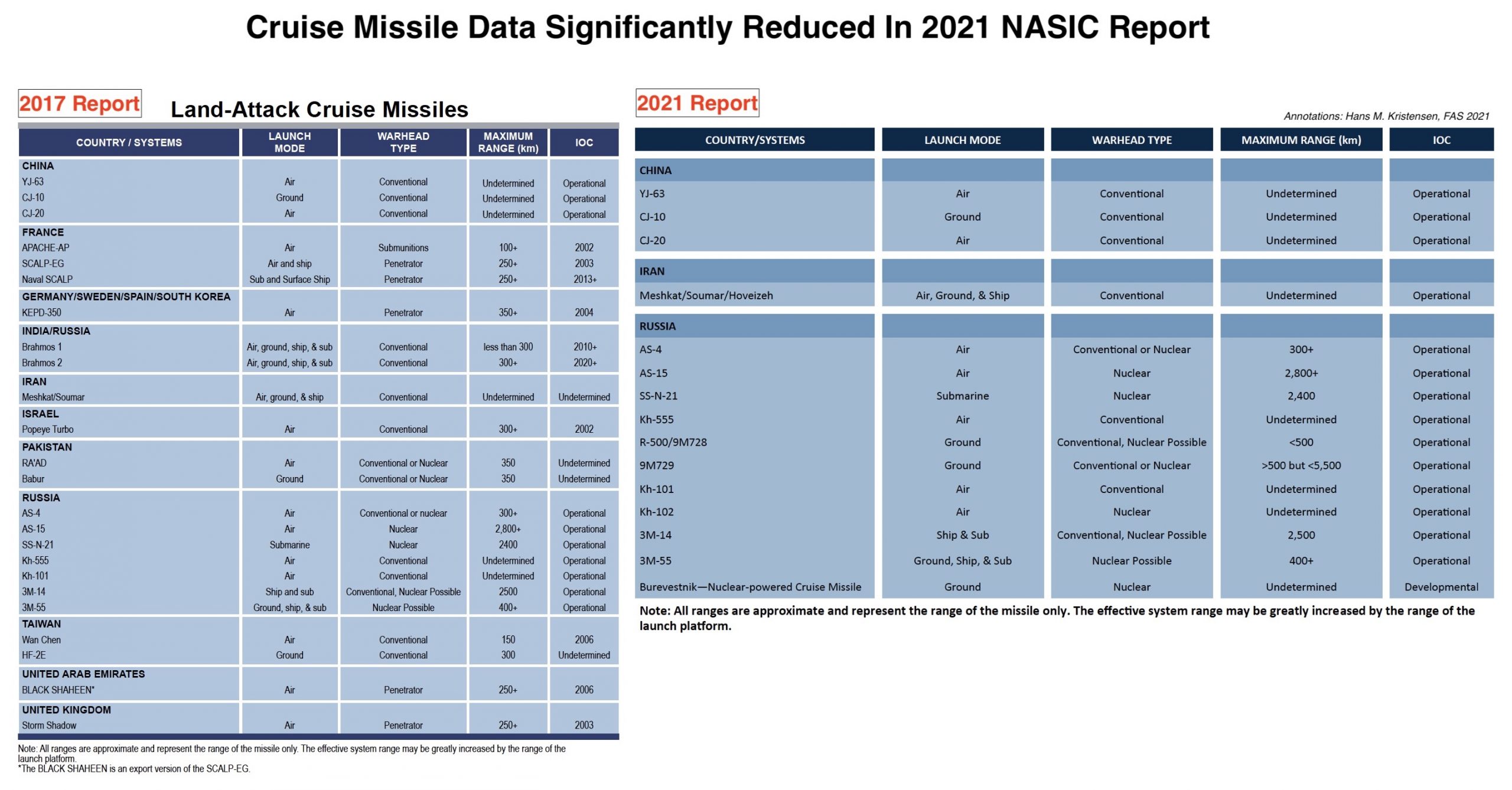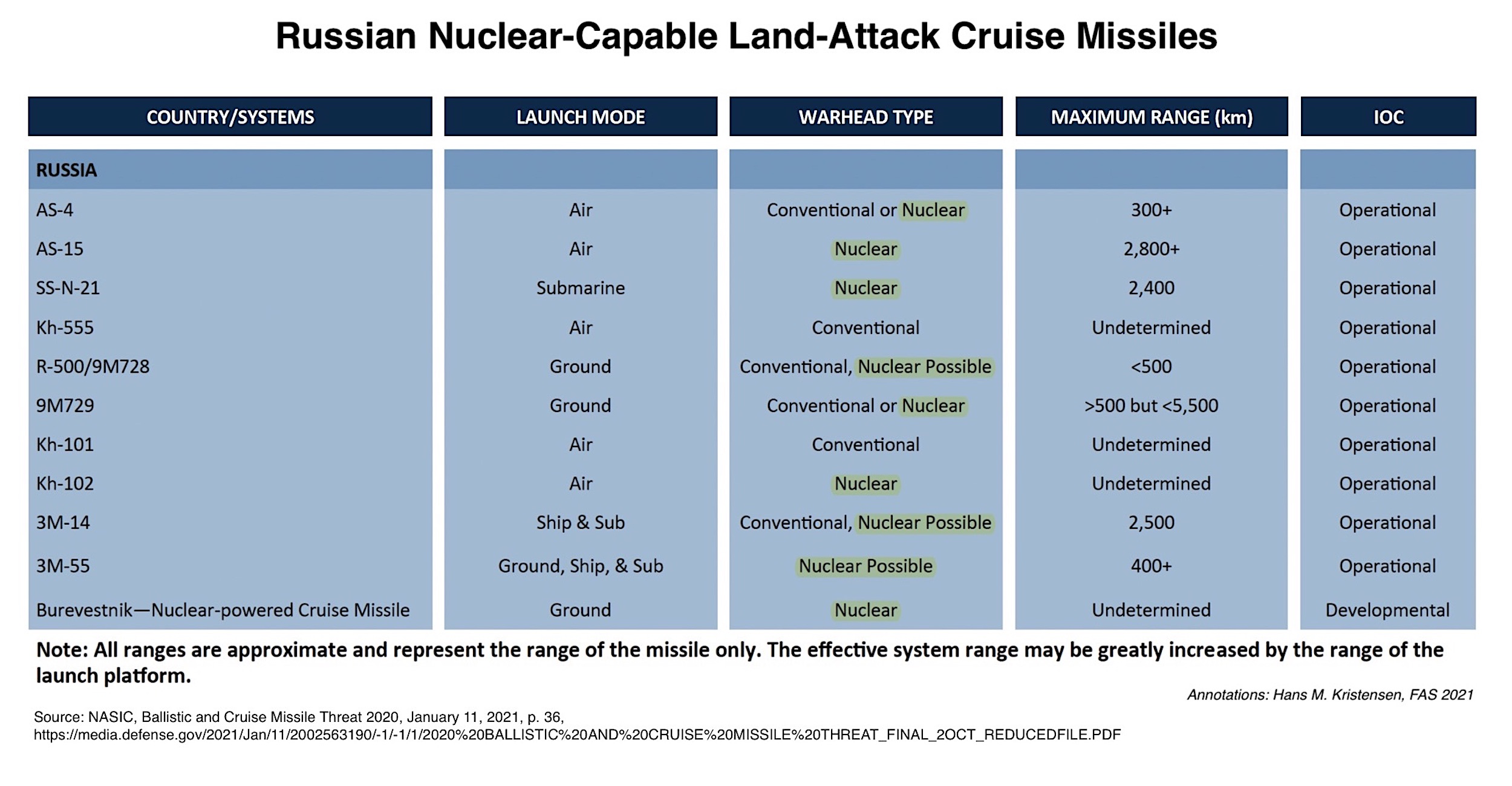New NASIC Report Appears Watered Down And Out Of Date
The US Air Force National Air and Space Intelligence Center (NASIC) has published a new version of its widely referenced Ballistic and Cruise Missile Threat report.
The agency normally puts out an updated version of the report every four years. The previous version dates from 2017.
The 2021 report (dated 2020) provides information on developments in many countries but is clearly focused on China, Iran, North Korea, and Russia. Especially the North Korean data is updated because of the significant developments since 2017.
The most interesting new information in the updated report is probably that the new Chinese JL-3 sea-launched ballistic missile (SLBM) is capable of carrying multiple warheads.
Overall, however, the new report may be equally interesting because of what it does not include. There are a number of cases where the report is scaled back compared with previous versions. And throughout the report, much of the data clearly hasn’t been updated since 2018. In some places it is even inconsistent and self-contradicting.
The most significant data reduction is in the cruise missile section where the report no longer lists countries other than Russia, China, and Iran. This is a significant change from previous reports that listed a wide range of other countries, including India and Pakistan and many others that have important cruise missile programs in development. The omission is curious because the report in all ballistic missile categories includes other countries.

Cruise missile data is significantly reduced in the new NASIC report compared with the previous version from 2017. Click on image to view full size.
Other examples of reduced data include the overview of ballistic missile launches, which for some reason does not show data for 2019 and 2020. Nor is it clear from the table which countries are included.
Also, in some descriptions of missile program developments the report appears to be out of date and not update on recent developments. This includes the Russian SS-X-28 (RS-26 Rubezh) shorter-range ICBM, which the report portrays as an active program but only presents data for 2018. Likewise, the report does not mention the two additional boats being added to the Chinese SSBN fleet. Moreover, the new section with air-launched ballistic missiles only includes Russia but leaves out Chinese developments and only appears to include data up through early 2018.
Whether these omissions reflect changes in classification rules, chaos is the Intelligence Community under the Trump administration, or simply oversight is unknown.
Below follows highlights of some of the main nuclear issues in the new report.
Russian Nuclear Forces
Information about Russian ballistic and cruise missile programs dominate the report, but less so than in previous versions. NASIC says Russia currently has approximately 1,400 nuclear warheads deployed on ICBMs and SLBMs, a reduction from the “over 1,500” reported in 2017. The new number is well known from the release of New START data and is very close to the 1,420 warheads we estimated in our Russian Nuclear Notebook last year.
NASIC repeats the projection from 2017, that “the number of missiles in the Russian ICBM force will continue to decrease because of arms control agreements, aging missiles, and resource constraints….”
The statement that “Russia retains over 1,000 nuclear warheads on ICBMs” is curious, however, because would imply the SLBM force is loaded with fewer warheads than normally assumed. The warhead loading attributed to the SS-N-32 (Bulava) is 6, the number declared by Russia under the START treaty, and less than the 10 warheads that is often claimed by unofficial sources.
The new version describes continued development of the SS-28 (RS-26 (Rubezh) shorter-range ICBM suspected by some to actually be an IRBM. But the report only lists development activities up through 2018 and nothing since. The system is widely thought to have been mothballed due to budget constraints.
The cruise missile section attributes nuclear capability – or possible nuclear capability – to most of the Russian missiles listed. Six systems are positively identified as nuclear, including the Kh-102, which was not listed in the 2017 report. Two of the nuclear systems are dual-capable, including the 9M729 (SSC-8) missile the US said violated the now-abandoned INF treaty, while 3 missiles are listed as “Conventional, Nuclear Possible.” That includes the 9M728 (R-500) cruise missile (SSC-7) launched by the Iskander system, the 3M-14 (Kalibr) cruise missile (SS-N-30), and the 3M-55 (Yakhont, P-800) cruise missile (SS-N-26).

NASIC attributes nuclear capability to nine Russian land-attack cruise missiles, three of them “possible.” Click on image to view full size.
The designation of “nuclear possible” for the SS-N-30 (3M-14, often called the Kalibr even though Kalibr is strictly speaking the name of the launcher system) is curious because the Russian government has clearly stated that the missile is nuclear-capable.
Chinese Nuclear Forces
The biggest news in the China section of the NASIC report is that the new JL-3 SLBM that will arm the next-generation Type 096 SSBN will be capable of delivering “multiple” warheads and have a range of more than 10,000 kilometers. That is a significant increase in capability compared with the JL-2 SLBM currently deployed on the Jin-class SSBNs and is likely part of the reason for the projection that China’s nuclear stockpile might double over the next decade.

NASIC reports that China’s next-generation JL-3 SLBM will be capable of carrying “multiple” warheads. Click on image to view full size.
Despite this increased range, however, a Type 096 operating from the current SSBN base in the South China Sea would not be able to strike targets in the continental United States. To be able to reach targets in the continental United States, an SSBN would have to launch its missile from the Bohai Sea. That would bring almost one-third of the continental United States within range. To target Washington, DC, however, a Type 096 SSBN would still have to deploy deep into the Pacific.
The new DF-41 (CSS-20) has lost its “-X-“ designation (CSS-X-20), which indicates that NASIC considers the missile has finished development is now being deployed. A total of 16+ launchers are listed, probably based on the number attending the 2019 parade in Beijing and the number seen operating in the Jilantai training area.
The number of DF-31A and DF-31AG launchers is very low, 15+ and 16+ respectively, which is strange given the number of bases observed with the launchers. Of course, “+” can mean anything and we estimate the number of launchers is probably twice that number. Also interesting is that the DF-31AG is listed as “UNK” (unknown) for warheads per missile. The DF-31A is listed with one warhead, which suggests that the AG version potentially could have a different payload. Nowhere else is the AG payload listed as different or even multiple warheads.
The NASIC report projection for the increase in Chinese nuclear ICBM warheads that can reach the United States is inconsistent and self-contradicting. In one section (p. 3) the report predicts “the number of Chinese ICBM nuclear warheads capable of reaching the United States potentially expanding to well over 200 within the next 5 years.” But in another section (p. 27), the report states that the “number of warheads on Chinese ICBMs capable of threatening the United States is expected to grow to well over 100 in the next 5 years.” The projection of “well over 100” was also listed in the 2017 report, and the “well over 200” projection matches the projection made in the DOD annual report on Chinese military developments. So the authors of the NASIC might simply have forgotten to update the text.
On Chinese shorter-range ballistic missiles, the NASIC report only mentions DF-21A (CSS-5 Mod 2) as nuclear, but not the CSS-5 Mod 6 version. The Mod 6 version (potentially called DF-21E) was first mentioned in the 2016 DOD report on Chinese military developments and has been included since.
Newer missiles finally get designations: The dual-capable DF-26 is called the CSS-18, and the conventional (possibly) DF-17 is called the CSS-22. NASIC continues to list the DF-26 range as less (3,000+ km) than the annual DOD China report (4,000 km).
An in case anyone was tempted, no, none of China’s cruise missiles are listed as nuclear-capable.
Pakistani Nuclear Forces
The report provides no new information about Pakistani nuclear-capable ballistic missiles. As with several other sections in the report, the information does not appear to have been updated much beyond 2018, if at all. As such, status information should be read with caution.
The Shaheen-III MRBM is still not deployed, nor is the Ababeel MRBM that NASIC describes as a “MIRV version.” It has only been flight-tested once.
The tactical nuclear-capable NASR is listed with a range of 60 km, the same as in 2017, even though the Pakistani government has since claimed the range has been extended to 70 km.
Because the new NASIC report no longer includes data on Pakistan’s cruise missiles, neither the Babur nor the RAAD programs are described. Nor is any information provided about the efforts by the Pakistani navy to develop a submarine-launched nuclear-capable cruise missile.
Indian Nuclear Forces
Similar to other sections of the report, the data on Indian programs are tainted by the fact that some information does not appear to have been updated since 2018, and that the cruise missile section does not include India at all.
According to the report, Agni II and Agni III MRBMs are still deployed in very low numbers, fewer than 10 launchers, the same number reported in 2017. That number implies only a single brigade of each missile. But, again, it is not clear this information has actually been updated.
Nor are the Agni IV or the Agni V listed as deployed yet.
North Korean Forces
The North Korean sections are main interesting because of the inclusion of data on several systems test-launched since the previous report in 2017. This contrasts several other data set in the report, which do not appear to have been updated past 2018. But since the North Korean long-range tests occurred in 2017, this may explain why they are included.
NASIC provides official (unclassified) range estimates for these missiles:
The Hwasong-12 IRBM range has been increased from 3,000+ km in 2017 to 4,500+ km in the new report.
On the ICBMs, the Taepo Dong 2 no longer has a range estimate. The Hwasong-13 and Hwasong-14 range estimates have been raised from the generic 5,500+ km in the 2017 report to 12,000 km and 10,000+ km, respectively, in the new report, and the new Hwasong-15 has been added with a range estimate of 12,000+ km. The warhead loading estimates for the Hwasong-14 and Hwasong-15 are “unknown” and none of the ICBMs are listed as deployed.
On submarine-launched missiles, the NASIC report lists two: the Puguksong-1 and Pukguksong-3. Both have range estimates of 1,000+ km and the warhead estimate for the Pukguksong-3 is unknown (“UNK”). Neither is deployed. The new Pukguksong-4 paraded in October 2020 is not listed, not is the newest Pukguksong-5 displayed in early 2021 mentioned.
Additional background information:
• Russian nuclear forces, 2020
• Chinese nuclear forces, 2020
• Status of world nuclear forces
The FY2026 National Defense Authorization Act (NDAA) paints a picture of a Congress that is working to both protect and accelerate nuclear modernization programs while simultaneously lacking trust in the Pentagon and the Department of Energy to execute them.
While advanced Chinese language proficiency and cultural familiarity remain irreplaceable skills, they are neither necessary nor sufficient for successful open-source analysis on China’s nuclear forces.
Satellite imagery has long served as a tool for observing on-the-ground activity worldwide, and offers especially valuable insights into the operation, development, and physical features related to nuclear technology.
This report outlines a framework relying on “Cooperative Technical Means” for effective arms control verification based on remote sensing, avoiding on-site inspections but maintaining a level of transparency that allows for immediate detection of changes in nuclear posture or a significant build-up above agreed limits.